HI5016 - Inter and Intra-Industry Trade: Case Studies & Analysis
VerifiedAdded on 2023/03/31
|13
|3468
|397
Report
AI Summary
This research paper provides a detailed analysis of inter-industry and intra-industry trade, two key concepts in international economics. It begins by defining and differentiating between these trade types, highlighting the significance of intra-industry trade in the context of globalization. The paper then presents case studies of Pakistan and the European Union to illustrate the practical implications and benefits of each trade model. The analysis reveals that intra-industry trade, characterized by the exchange of similar but differentiated products, has become increasingly important due to its role in stimulating innovation, increasing product variety, and promoting economic stability. The paper concludes by emphasizing the complementary roles of both inter-industry and intra-industry trade in driving economic growth and development, particularly through strategic economic modifications at the national level.
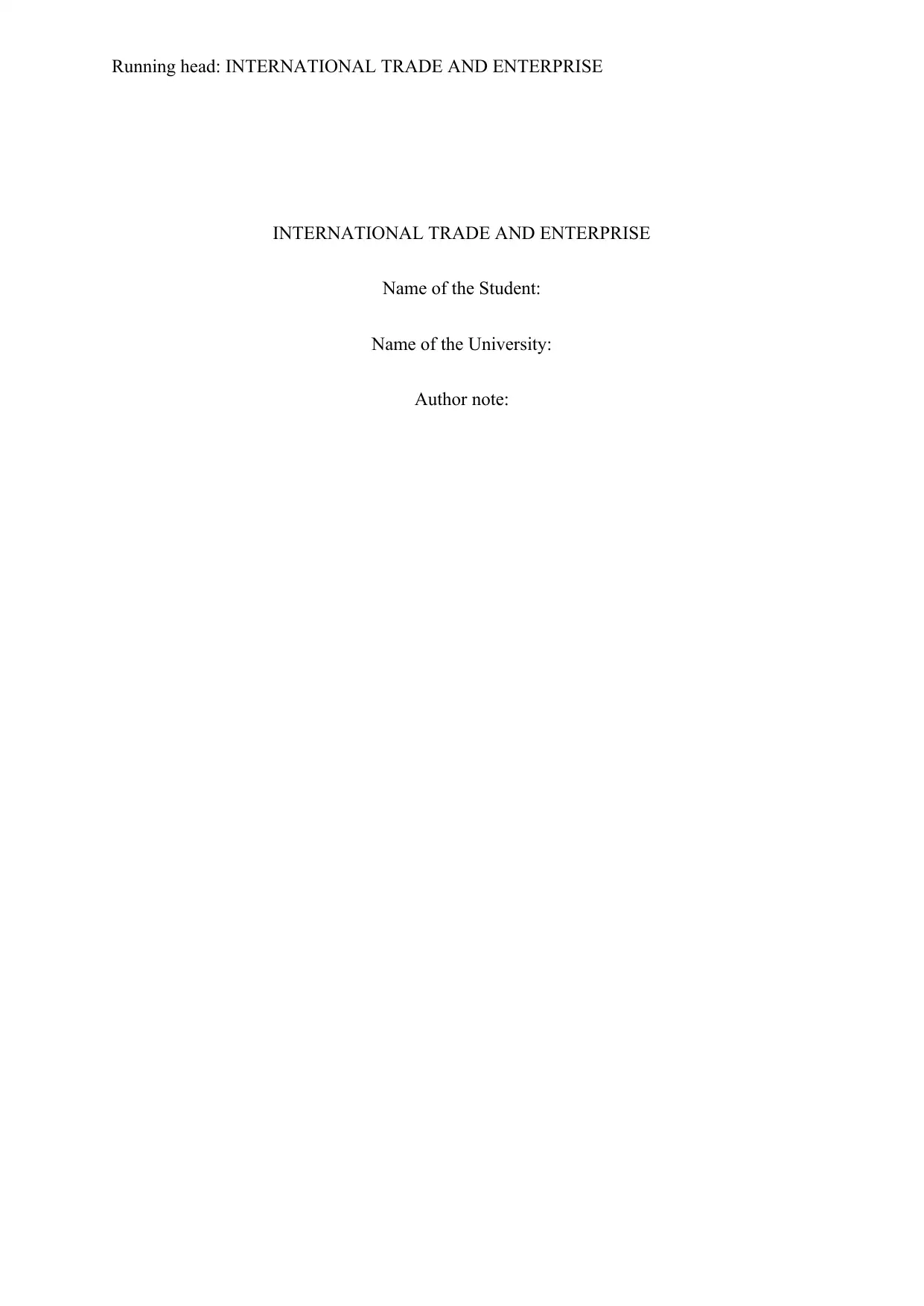
Running head: INTERNATIONAL TRADE AND ENTERPRISE
INTERNATIONAL TRADE AND ENTERPRISE
Name of the Student:
Name of the University:
Author note:
INTERNATIONAL TRADE AND ENTERPRISE
Name of the Student:
Name of the University:
Author note:
Paraphrase This Document
Need a fresh take? Get an instant paraphrase of this document with our AI Paraphraser
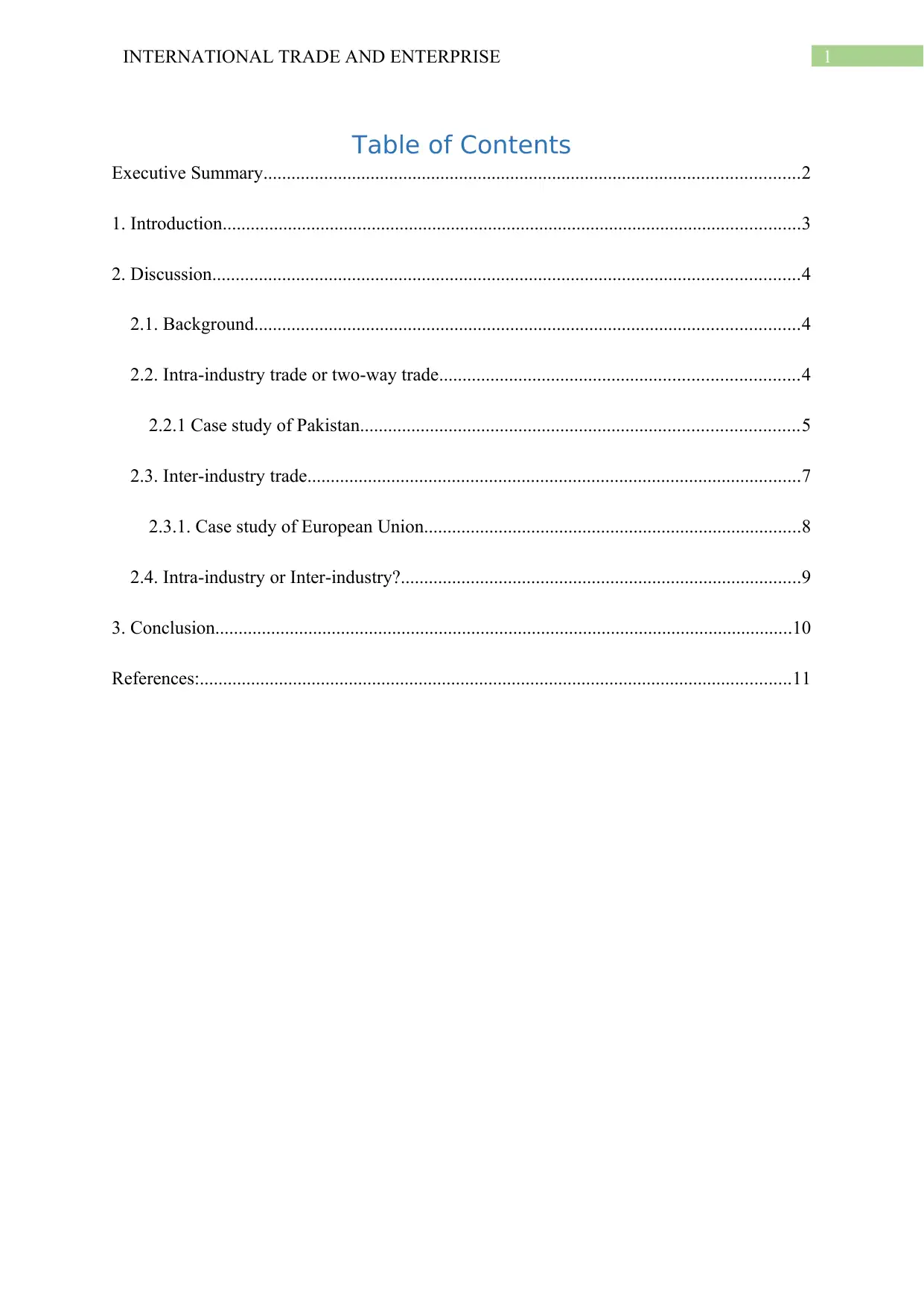
1INTERNATIONAL TRADE AND ENTERPRISE
Table of Contents
Executive Summary...................................................................................................................2
1. Introduction............................................................................................................................3
2. Discussion..............................................................................................................................4
2.1. Background.....................................................................................................................4
2.2. Intra-industry trade or two-way trade.............................................................................4
2.2.1 Case study of Pakistan..............................................................................................5
2.3. Inter-industry trade..........................................................................................................7
2.3.1. Case study of European Union.................................................................................8
2.4. Intra-industry or Inter-industry?......................................................................................9
3. Conclusion............................................................................................................................10
References:...............................................................................................................................11
Table of Contents
Executive Summary...................................................................................................................2
1. Introduction............................................................................................................................3
2. Discussion..............................................................................................................................4
2.1. Background.....................................................................................................................4
2.2. Intra-industry trade or two-way trade.............................................................................4
2.2.1 Case study of Pakistan..............................................................................................5
2.3. Inter-industry trade..........................................................................................................7
2.3.1. Case study of European Union.................................................................................8
2.4. Intra-industry or Inter-industry?......................................................................................9
3. Conclusion............................................................................................................................10
References:...............................................................................................................................11
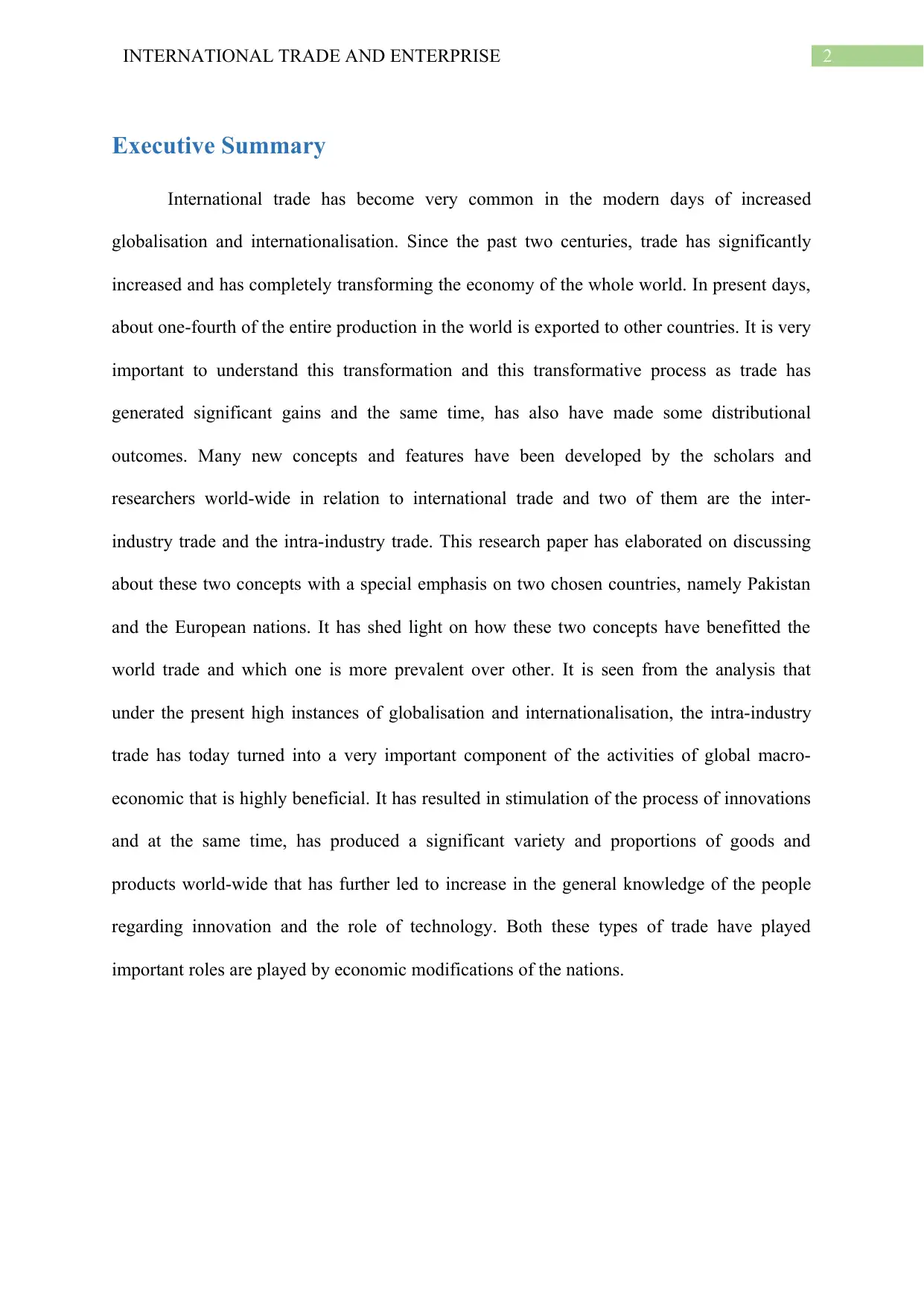
2INTERNATIONAL TRADE AND ENTERPRISE
Executive Summary
International trade has become very common in the modern days of increased
globalisation and internationalisation. Since the past two centuries, trade has significantly
increased and has completely transforming the economy of the whole world. In present days,
about one-fourth of the entire production in the world is exported to other countries. It is very
important to understand this transformation and this transformative process as trade has
generated significant gains and the same time, has also have made some distributional
outcomes. Many new concepts and features have been developed by the scholars and
researchers world-wide in relation to international trade and two of them are the inter-
industry trade and the intra-industry trade. This research paper has elaborated on discussing
about these two concepts with a special emphasis on two chosen countries, namely Pakistan
and the European nations. It has shed light on how these two concepts have benefitted the
world trade and which one is more prevalent over other. It is seen from the analysis that
under the present high instances of globalisation and internationalisation, the intra-industry
trade has today turned into a very important component of the activities of global macro-
economic that is highly beneficial. It has resulted in stimulation of the process of innovations
and at the same time, has produced a significant variety and proportions of goods and
products world-wide that has further led to increase in the general knowledge of the people
regarding innovation and the role of technology. Both these types of trade have played
important roles are played by economic modifications of the nations.
Executive Summary
International trade has become very common in the modern days of increased
globalisation and internationalisation. Since the past two centuries, trade has significantly
increased and has completely transforming the economy of the whole world. In present days,
about one-fourth of the entire production in the world is exported to other countries. It is very
important to understand this transformation and this transformative process as trade has
generated significant gains and the same time, has also have made some distributional
outcomes. Many new concepts and features have been developed by the scholars and
researchers world-wide in relation to international trade and two of them are the inter-
industry trade and the intra-industry trade. This research paper has elaborated on discussing
about these two concepts with a special emphasis on two chosen countries, namely Pakistan
and the European nations. It has shed light on how these two concepts have benefitted the
world trade and which one is more prevalent over other. It is seen from the analysis that
under the present high instances of globalisation and internationalisation, the intra-industry
trade has today turned into a very important component of the activities of global macro-
economic that is highly beneficial. It has resulted in stimulation of the process of innovations
and at the same time, has produced a significant variety and proportions of goods and
products world-wide that has further led to increase in the general knowledge of the people
regarding innovation and the role of technology. Both these types of trade have played
important roles are played by economic modifications of the nations.
⊘ This is a preview!⊘
Do you want full access?
Subscribe today to unlock all pages.

Trusted by 1+ million students worldwide
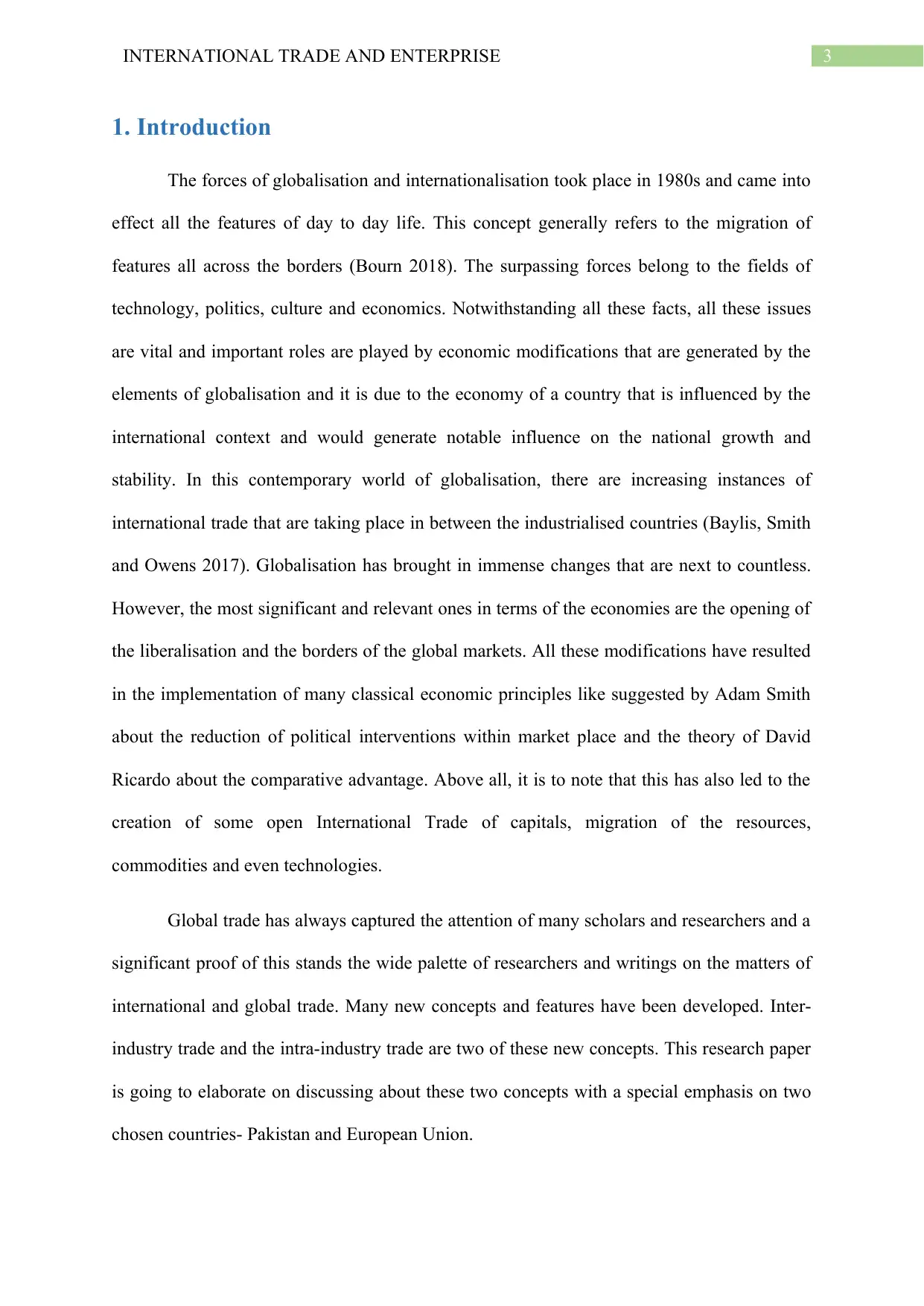
3INTERNATIONAL TRADE AND ENTERPRISE
1. Introduction
The forces of globalisation and internationalisation took place in 1980s and came into
effect all the features of day to day life. This concept generally refers to the migration of
features all across the borders (Bourn 2018). The surpassing forces belong to the fields of
technology, politics, culture and economics. Notwithstanding all these facts, all these issues
are vital and important roles are played by economic modifications that are generated by the
elements of globalisation and it is due to the economy of a country that is influenced by the
international context and would generate notable influence on the national growth and
stability. In this contemporary world of globalisation, there are increasing instances of
international trade that are taking place in between the industrialised countries (Baylis, Smith
and Owens 2017). Globalisation has brought in immense changes that are next to countless.
However, the most significant and relevant ones in terms of the economies are the opening of
the liberalisation and the borders of the global markets. All these modifications have resulted
in the implementation of many classical economic principles like suggested by Adam Smith
about the reduction of political interventions within market place and the theory of David
Ricardo about the comparative advantage. Above all, it is to note that this has also led to the
creation of some open International Trade of capitals, migration of the resources,
commodities and even technologies.
Global trade has always captured the attention of many scholars and researchers and a
significant proof of this stands the wide palette of researchers and writings on the matters of
international and global trade. Many new concepts and features have been developed. Inter-
industry trade and the intra-industry trade are two of these new concepts. This research paper
is going to elaborate on discussing about these two concepts with a special emphasis on two
chosen countries- Pakistan and European Union.
1. Introduction
The forces of globalisation and internationalisation took place in 1980s and came into
effect all the features of day to day life. This concept generally refers to the migration of
features all across the borders (Bourn 2018). The surpassing forces belong to the fields of
technology, politics, culture and economics. Notwithstanding all these facts, all these issues
are vital and important roles are played by economic modifications that are generated by the
elements of globalisation and it is due to the economy of a country that is influenced by the
international context and would generate notable influence on the national growth and
stability. In this contemporary world of globalisation, there are increasing instances of
international trade that are taking place in between the industrialised countries (Baylis, Smith
and Owens 2017). Globalisation has brought in immense changes that are next to countless.
However, the most significant and relevant ones in terms of the economies are the opening of
the liberalisation and the borders of the global markets. All these modifications have resulted
in the implementation of many classical economic principles like suggested by Adam Smith
about the reduction of political interventions within market place and the theory of David
Ricardo about the comparative advantage. Above all, it is to note that this has also led to the
creation of some open International Trade of capitals, migration of the resources,
commodities and even technologies.
Global trade has always captured the attention of many scholars and researchers and a
significant proof of this stands the wide palette of researchers and writings on the matters of
international and global trade. Many new concepts and features have been developed. Inter-
industry trade and the intra-industry trade are two of these new concepts. This research paper
is going to elaborate on discussing about these two concepts with a special emphasis on two
chosen countries- Pakistan and European Union.
Paraphrase This Document
Need a fresh take? Get an instant paraphrase of this document with our AI Paraphraser
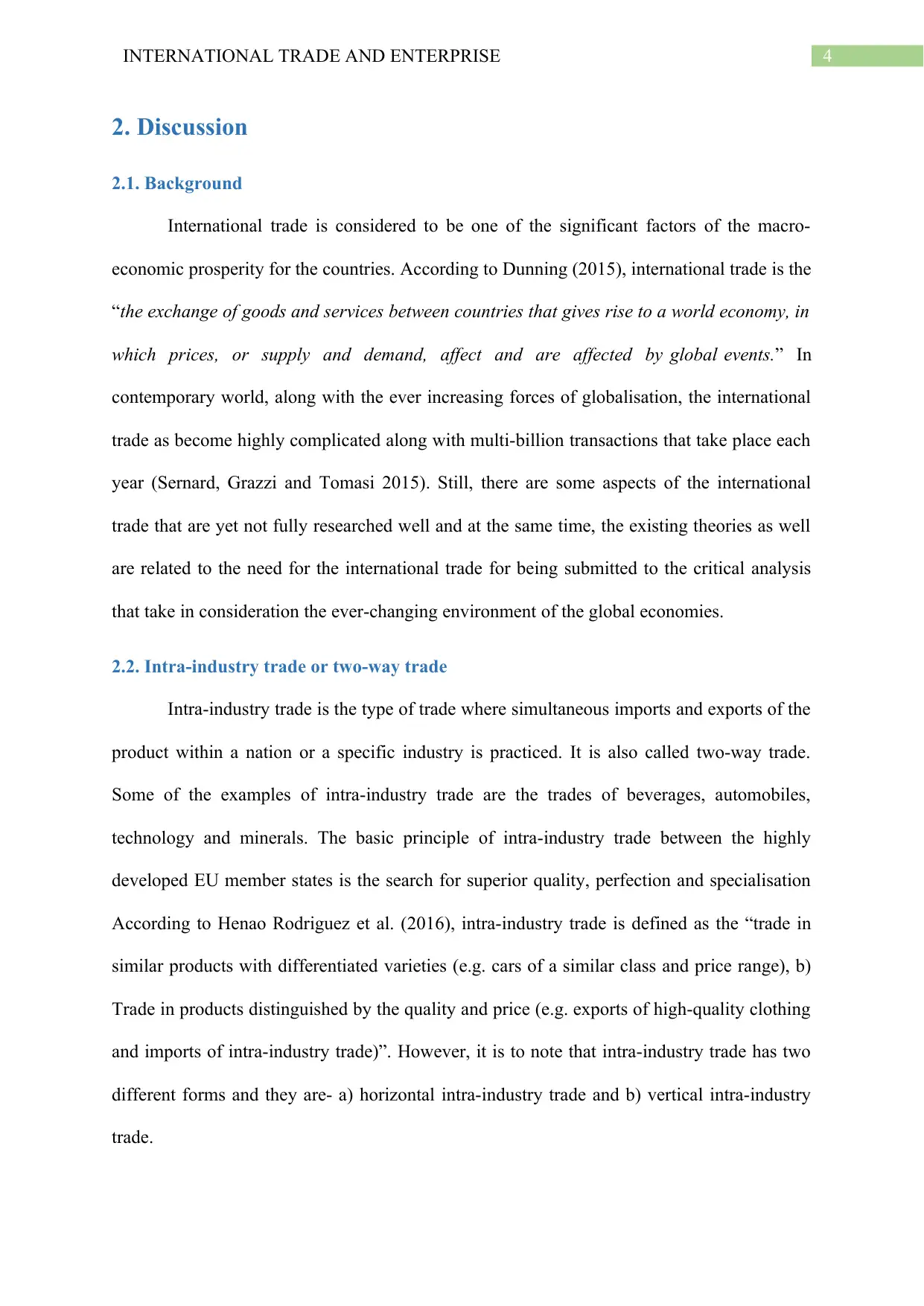
4INTERNATIONAL TRADE AND ENTERPRISE
2. Discussion
2.1. Background
International trade is considered to be one of the significant factors of the macro-
economic prosperity for the countries. According to Dunning (2015), international trade is the
“the exchange of goods and services between countries that gives rise to a world economy, in
which prices, or supply and demand, affect and are affected by global events.” In
contemporary world, along with the ever increasing forces of globalisation, the international
trade as become highly complicated along with multi-billion transactions that take place each
year (Sernard, Grazzi and Tomasi 2015). Still, there are some aspects of the international
trade that are yet not fully researched well and at the same time, the existing theories as well
are related to the need for the international trade for being submitted to the critical analysis
that take in consideration the ever-changing environment of the global economies.
2.2. Intra-industry trade or two-way trade
Intra-industry trade is the type of trade where simultaneous imports and exports of the
product within a nation or a specific industry is practiced. It is also called two-way trade.
Some of the examples of intra-industry trade are the trades of beverages, automobiles,
technology and minerals. The basic principle of intra-industry trade between the highly
developed EU member states is the search for superior quality, perfection and specialisation
According to Henao Rodriguez et al. (2016), intra-industry trade is defined as the “trade in
similar products with differentiated varieties (e.g. cars of a similar class and price range), b)
Trade in products distinguished by the quality and price (e.g. exports of high-quality clothing
and imports of intra-industry trade)”. However, it is to note that intra-industry trade has two
different forms and they are- a) horizontal intra-industry trade and b) vertical intra-industry
trade.
2. Discussion
2.1. Background
International trade is considered to be one of the significant factors of the macro-
economic prosperity for the countries. According to Dunning (2015), international trade is the
“the exchange of goods and services between countries that gives rise to a world economy, in
which prices, or supply and demand, affect and are affected by global events.” In
contemporary world, along with the ever increasing forces of globalisation, the international
trade as become highly complicated along with multi-billion transactions that take place each
year (Sernard, Grazzi and Tomasi 2015). Still, there are some aspects of the international
trade that are yet not fully researched well and at the same time, the existing theories as well
are related to the need for the international trade for being submitted to the critical analysis
that take in consideration the ever-changing environment of the global economies.
2.2. Intra-industry trade or two-way trade
Intra-industry trade is the type of trade where simultaneous imports and exports of the
product within a nation or a specific industry is practiced. It is also called two-way trade.
Some of the examples of intra-industry trade are the trades of beverages, automobiles,
technology and minerals. The basic principle of intra-industry trade between the highly
developed EU member states is the search for superior quality, perfection and specialisation
According to Henao Rodriguez et al. (2016), intra-industry trade is defined as the “trade in
similar products with differentiated varieties (e.g. cars of a similar class and price range), b)
Trade in products distinguished by the quality and price (e.g. exports of high-quality clothing
and imports of intra-industry trade)”. However, it is to note that intra-industry trade has two
different forms and they are- a) horizontal intra-industry trade and b) vertical intra-industry
trade.
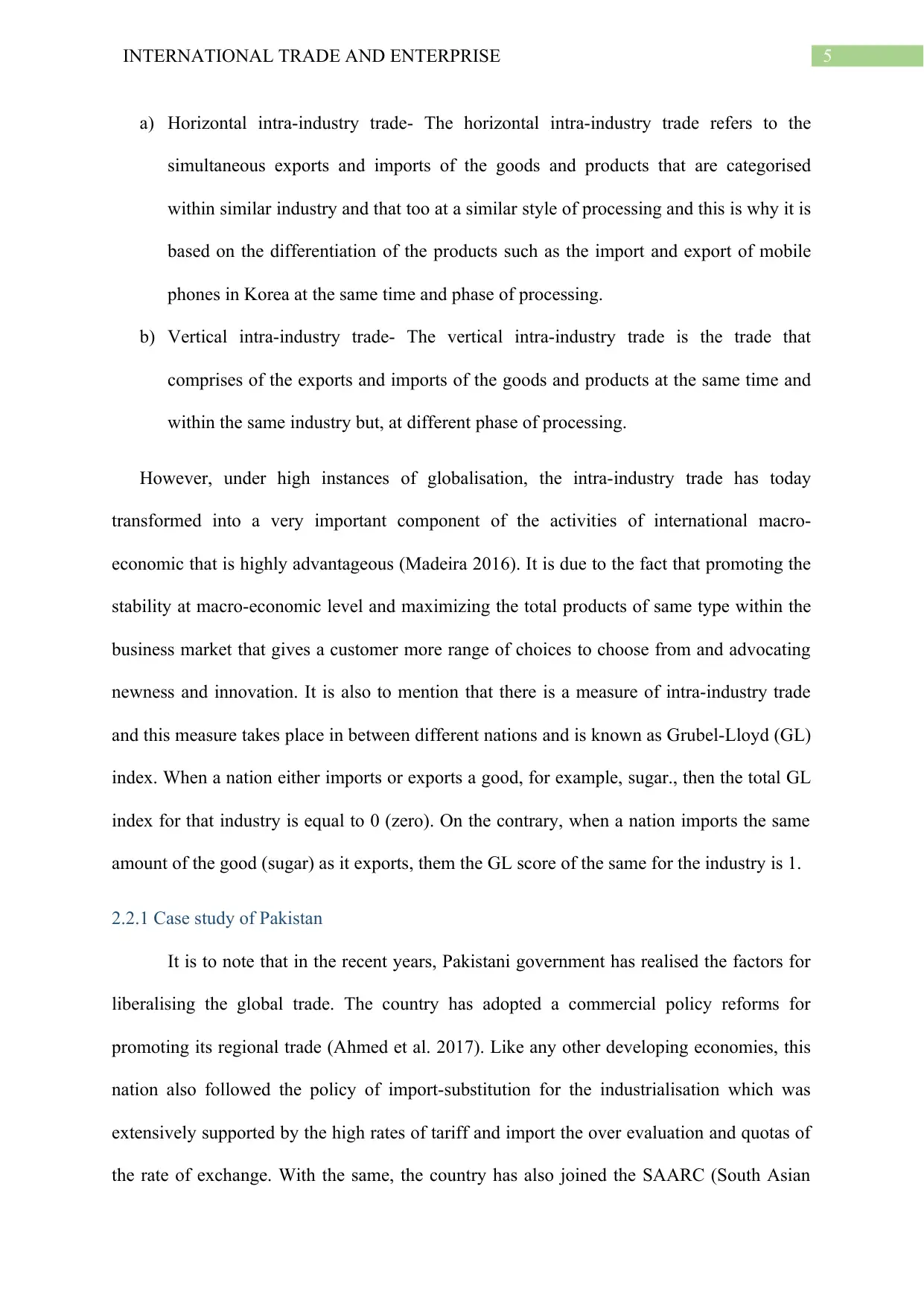
5INTERNATIONAL TRADE AND ENTERPRISE
a) Horizontal intra-industry trade- The horizontal intra-industry trade refers to the
simultaneous exports and imports of the goods and products that are categorised
within similar industry and that too at a similar style of processing and this is why it is
based on the differentiation of the products such as the import and export of mobile
phones in Korea at the same time and phase of processing.
b) Vertical intra-industry trade- The vertical intra-industry trade is the trade that
comprises of the exports and imports of the goods and products at the same time and
within the same industry but, at different phase of processing.
However, under high instances of globalisation, the intra-industry trade has today
transformed into a very important component of the activities of international macro-
economic that is highly advantageous (Madeira 2016). It is due to the fact that promoting the
stability at macro-economic level and maximizing the total products of same type within the
business market that gives a customer more range of choices to choose from and advocating
newness and innovation. It is also to mention that there is a measure of intra-industry trade
and this measure takes place in between different nations and is known as Grubel-Lloyd (GL)
index. When a nation either imports or exports a good, for example, sugar., then the total GL
index for that industry is equal to 0 (zero). On the contrary, when a nation imports the same
amount of the good (sugar) as it exports, them the GL score of the same for the industry is 1.
2.2.1 Case study of Pakistan
It is to note that in the recent years, Pakistani government has realised the factors for
liberalising the global trade. The country has adopted a commercial policy reforms for
promoting its regional trade (Ahmed et al. 2017). Like any other developing economies, this
nation also followed the policy of import-substitution for the industrialisation which was
extensively supported by the high rates of tariff and import the over evaluation and quotas of
the rate of exchange. With the same, the country has also joined the SAARC (South Asian
a) Horizontal intra-industry trade- The horizontal intra-industry trade refers to the
simultaneous exports and imports of the goods and products that are categorised
within similar industry and that too at a similar style of processing and this is why it is
based on the differentiation of the products such as the import and export of mobile
phones in Korea at the same time and phase of processing.
b) Vertical intra-industry trade- The vertical intra-industry trade is the trade that
comprises of the exports and imports of the goods and products at the same time and
within the same industry but, at different phase of processing.
However, under high instances of globalisation, the intra-industry trade has today
transformed into a very important component of the activities of international macro-
economic that is highly advantageous (Madeira 2016). It is due to the fact that promoting the
stability at macro-economic level and maximizing the total products of same type within the
business market that gives a customer more range of choices to choose from and advocating
newness and innovation. It is also to mention that there is a measure of intra-industry trade
and this measure takes place in between different nations and is known as Grubel-Lloyd (GL)
index. When a nation either imports or exports a good, for example, sugar., then the total GL
index for that industry is equal to 0 (zero). On the contrary, when a nation imports the same
amount of the good (sugar) as it exports, them the GL score of the same for the industry is 1.
2.2.1 Case study of Pakistan
It is to note that in the recent years, Pakistani government has realised the factors for
liberalising the global trade. The country has adopted a commercial policy reforms for
promoting its regional trade (Ahmed et al. 2017). Like any other developing economies, this
nation also followed the policy of import-substitution for the industrialisation which was
extensively supported by the high rates of tariff and import the over evaluation and quotas of
the rate of exchange. With the same, the country has also joined the SAARC (South Asian
⊘ This is a preview!⊘
Do you want full access?
Subscribe today to unlock all pages.

Trusted by 1+ million students worldwide
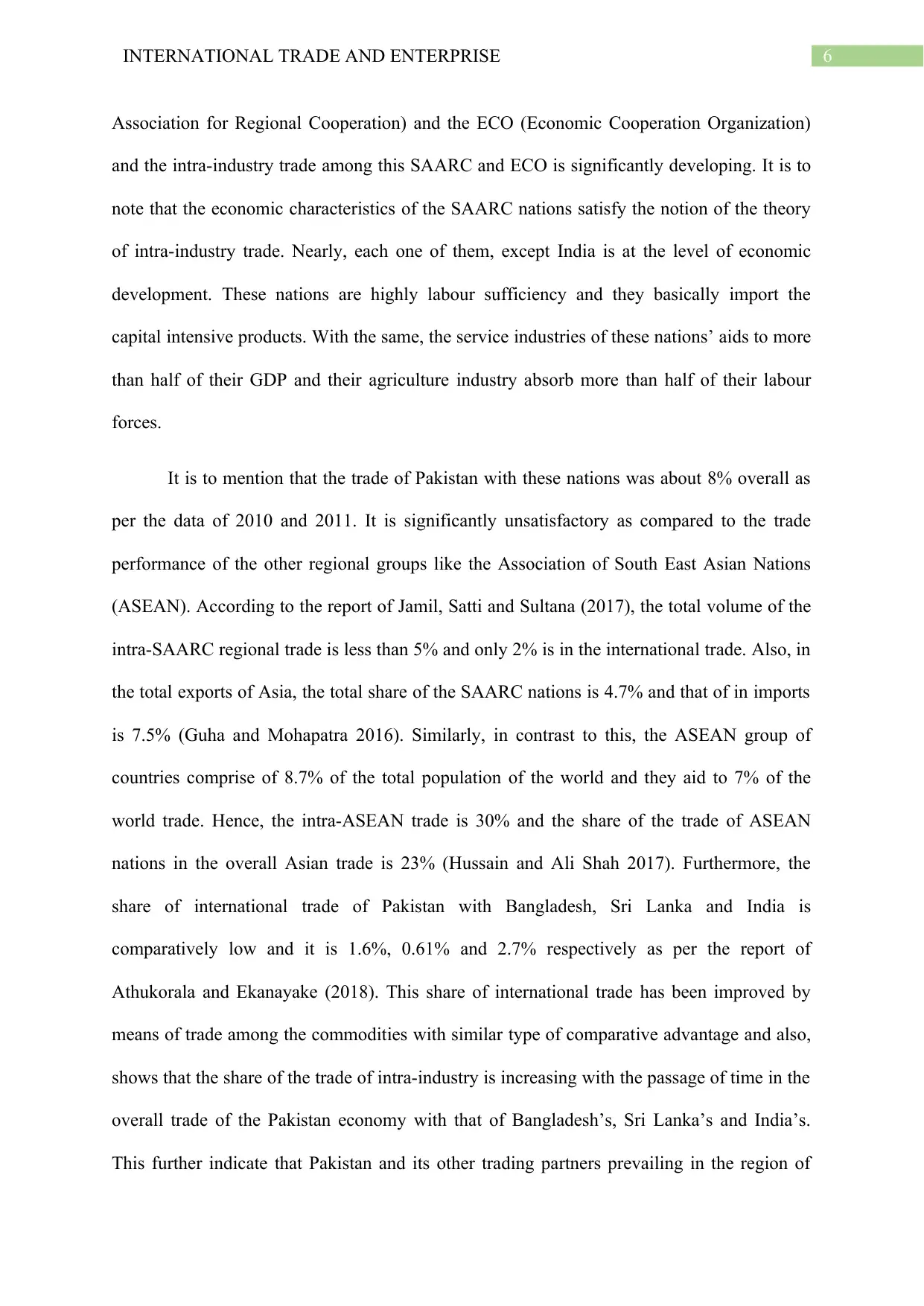
6INTERNATIONAL TRADE AND ENTERPRISE
Association for Regional Cooperation) and the ECO (Economic Cooperation Organization)
and the intra-industry trade among this SAARC and ECO is significantly developing. It is to
note that the economic characteristics of the SAARC nations satisfy the notion of the theory
of intra-industry trade. Nearly, each one of them, except India is at the level of economic
development. These nations are highly labour sufficiency and they basically import the
capital intensive products. With the same, the service industries of these nations’ aids to more
than half of their GDP and their agriculture industry absorb more than half of their labour
forces.
It is to mention that the trade of Pakistan with these nations was about 8% overall as
per the data of 2010 and 2011. It is significantly unsatisfactory as compared to the trade
performance of the other regional groups like the Association of South East Asian Nations
(ASEAN). According to the report of Jamil, Satti and Sultana (2017), the total volume of the
intra-SAARC regional trade is less than 5% and only 2% is in the international trade. Also, in
the total exports of Asia, the total share of the SAARC nations is 4.7% and that of in imports
is 7.5% (Guha and Mohapatra 2016). Similarly, in contrast to this, the ASEAN group of
countries comprise of 8.7% of the total population of the world and they aid to 7% of the
world trade. Hence, the intra-ASEAN trade is 30% and the share of the trade of ASEAN
nations in the overall Asian trade is 23% (Hussain and Ali Shah 2017). Furthermore, the
share of international trade of Pakistan with Bangladesh, Sri Lanka and India is
comparatively low and it is 1.6%, 0.61% and 2.7% respectively as per the report of
Athukorala and Ekanayake (2018). This share of international trade has been improved by
means of trade among the commodities with similar type of comparative advantage and also,
shows that the share of the trade of intra-industry is increasing with the passage of time in the
overall trade of the Pakistan economy with that of Bangladesh’s, Sri Lanka’s and India’s.
This further indicate that Pakistan and its other trading partners prevailing in the region of
Association for Regional Cooperation) and the ECO (Economic Cooperation Organization)
and the intra-industry trade among this SAARC and ECO is significantly developing. It is to
note that the economic characteristics of the SAARC nations satisfy the notion of the theory
of intra-industry trade. Nearly, each one of them, except India is at the level of economic
development. These nations are highly labour sufficiency and they basically import the
capital intensive products. With the same, the service industries of these nations’ aids to more
than half of their GDP and their agriculture industry absorb more than half of their labour
forces.
It is to mention that the trade of Pakistan with these nations was about 8% overall as
per the data of 2010 and 2011. It is significantly unsatisfactory as compared to the trade
performance of the other regional groups like the Association of South East Asian Nations
(ASEAN). According to the report of Jamil, Satti and Sultana (2017), the total volume of the
intra-SAARC regional trade is less than 5% and only 2% is in the international trade. Also, in
the total exports of Asia, the total share of the SAARC nations is 4.7% and that of in imports
is 7.5% (Guha and Mohapatra 2016). Similarly, in contrast to this, the ASEAN group of
countries comprise of 8.7% of the total population of the world and they aid to 7% of the
world trade. Hence, the intra-ASEAN trade is 30% and the share of the trade of ASEAN
nations in the overall Asian trade is 23% (Hussain and Ali Shah 2017). Furthermore, the
share of international trade of Pakistan with Bangladesh, Sri Lanka and India is
comparatively low and it is 1.6%, 0.61% and 2.7% respectively as per the report of
Athukorala and Ekanayake (2018). This share of international trade has been improved by
means of trade among the commodities with similar type of comparative advantage and also,
shows that the share of the trade of intra-industry is increasing with the passage of time in the
overall trade of the Pakistan economy with that of Bangladesh’s, Sri Lanka’s and India’s.
This further indicate that Pakistan and its other trading partners prevailing in the region of
Paraphrase This Document
Need a fresh take? Get an instant paraphrase of this document with our AI Paraphraser
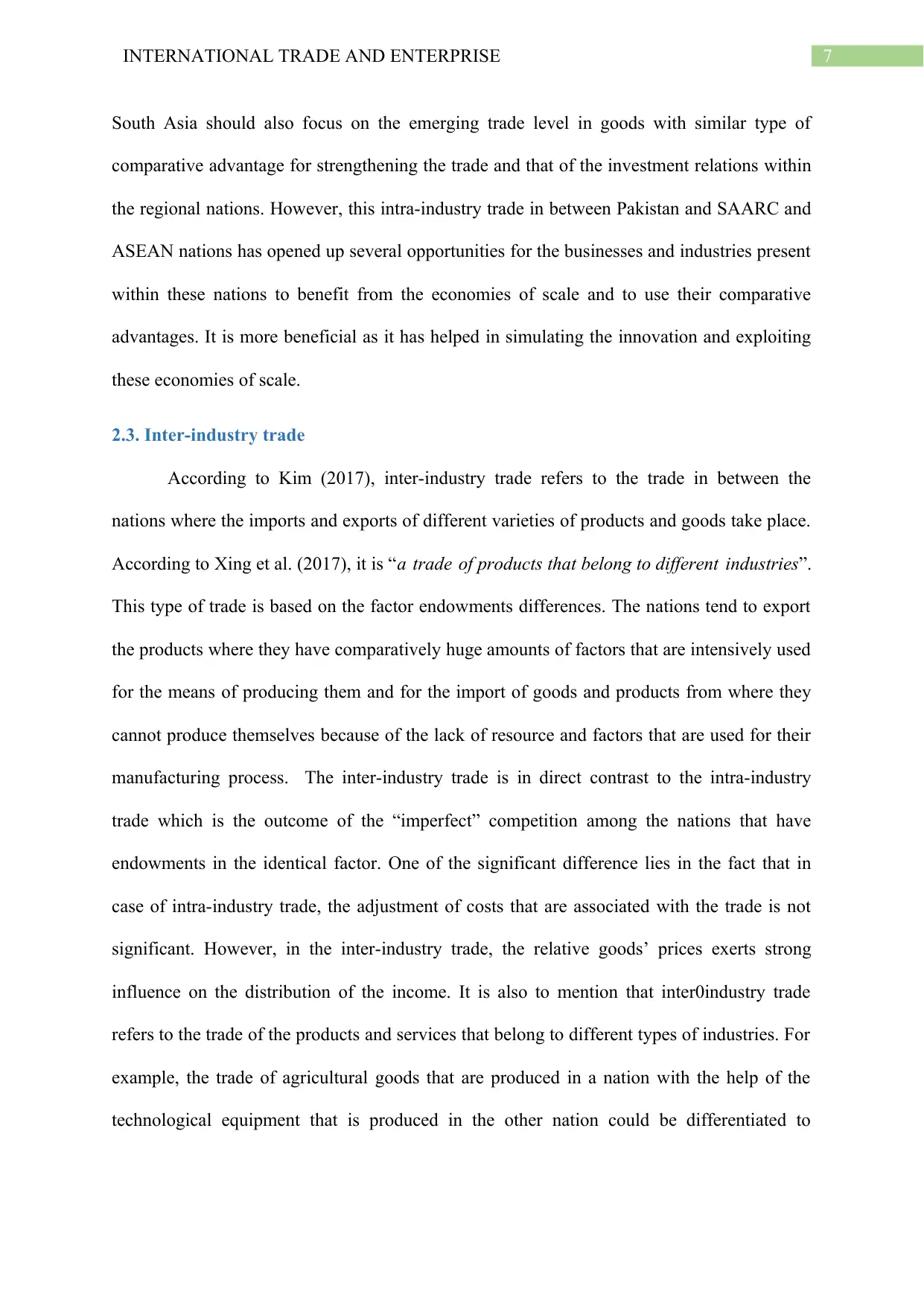
7INTERNATIONAL TRADE AND ENTERPRISE
South Asia should also focus on the emerging trade level in goods with similar type of
comparative advantage for strengthening the trade and that of the investment relations within
the regional nations. However, this intra-industry trade in between Pakistan and SAARC and
ASEAN nations has opened up several opportunities for the businesses and industries present
within these nations to benefit from the economies of scale and to use their comparative
advantages. It is more beneficial as it has helped in simulating the innovation and exploiting
these economies of scale.
2.3. Inter-industry trade
According to Kim (2017), inter-industry trade refers to the trade in between the
nations where the imports and exports of different varieties of products and goods take place.
According to Xing et al. (2017), it is “a trade of products that belong to different industries”.
This type of trade is based on the factor endowments differences. The nations tend to export
the products where they have comparatively huge amounts of factors that are intensively used
for the means of producing them and for the import of goods and products from where they
cannot produce themselves because of the lack of resource and factors that are used for their
manufacturing process. The inter-industry trade is in direct contrast to the intra-industry
trade which is the outcome of the “imperfect” competition among the nations that have
endowments in the identical factor. One of the significant difference lies in the fact that in
case of intra-industry trade, the adjustment of costs that are associated with the trade is not
significant. However, in the inter-industry trade, the relative goods’ prices exerts strong
influence on the distribution of the income. It is also to mention that inter0industry trade
refers to the trade of the products and services that belong to different types of industries. For
example, the trade of agricultural goods that are produced in a nation with the help of the
technological equipment that is produced in the other nation could be differentiated to
South Asia should also focus on the emerging trade level in goods with similar type of
comparative advantage for strengthening the trade and that of the investment relations within
the regional nations. However, this intra-industry trade in between Pakistan and SAARC and
ASEAN nations has opened up several opportunities for the businesses and industries present
within these nations to benefit from the economies of scale and to use their comparative
advantages. It is more beneficial as it has helped in simulating the innovation and exploiting
these economies of scale.
2.3. Inter-industry trade
According to Kim (2017), inter-industry trade refers to the trade in between the
nations where the imports and exports of different varieties of products and goods take place.
According to Xing et al. (2017), it is “a trade of products that belong to different industries”.
This type of trade is based on the factor endowments differences. The nations tend to export
the products where they have comparatively huge amounts of factors that are intensively used
for the means of producing them and for the import of goods and products from where they
cannot produce themselves because of the lack of resource and factors that are used for their
manufacturing process. The inter-industry trade is in direct contrast to the intra-industry
trade which is the outcome of the “imperfect” competition among the nations that have
endowments in the identical factor. One of the significant difference lies in the fact that in
case of intra-industry trade, the adjustment of costs that are associated with the trade is not
significant. However, in the inter-industry trade, the relative goods’ prices exerts strong
influence on the distribution of the income. It is also to mention that inter0industry trade
refers to the trade of the products and services that belong to different types of industries. For
example, the trade of agricultural goods that are produced in a nation with the help of the
technological equipment that is produced in the other nation could be differentiated to
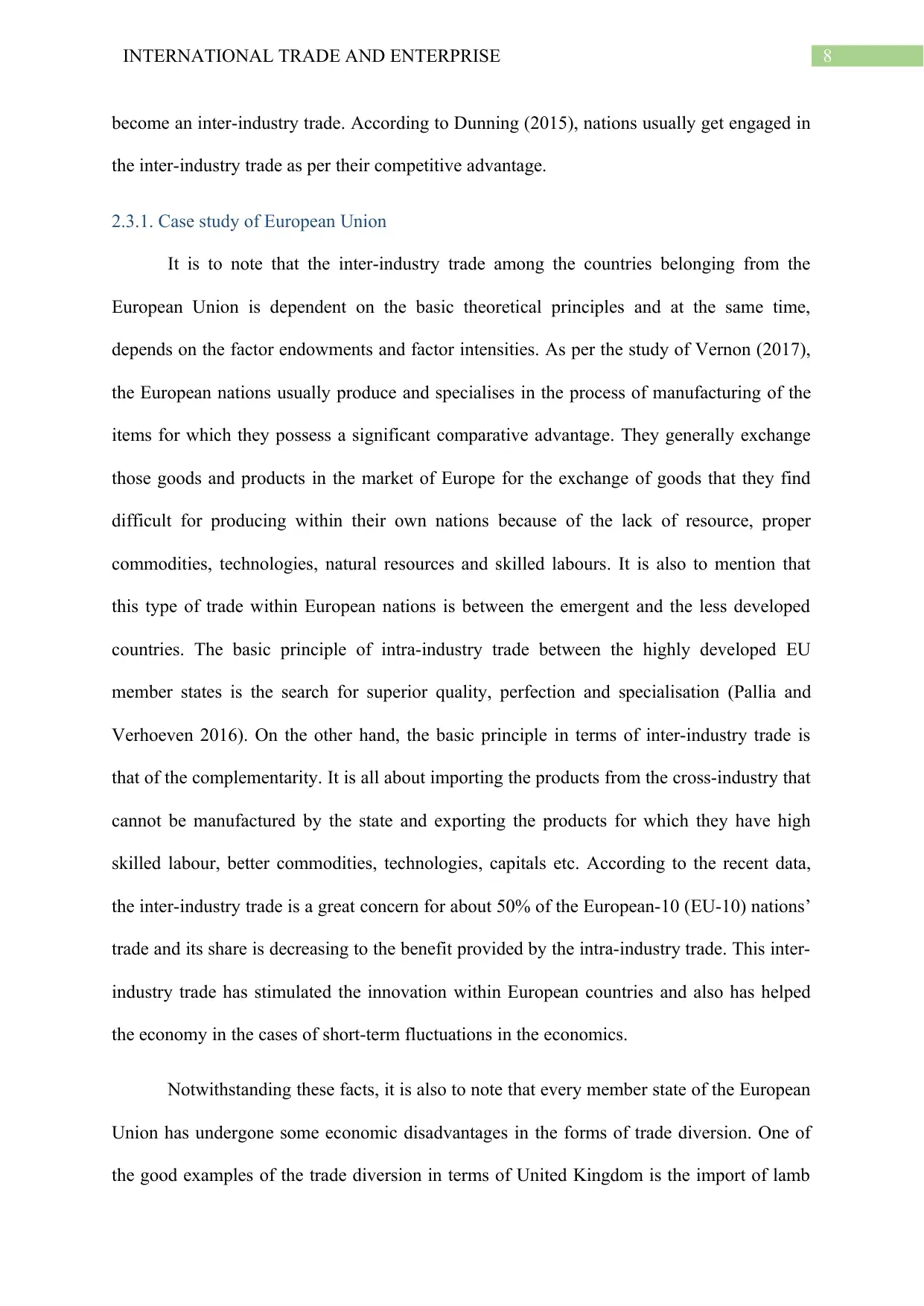
8INTERNATIONAL TRADE AND ENTERPRISE
become an inter-industry trade. According to Dunning (2015), nations usually get engaged in
the inter-industry trade as per their competitive advantage.
2.3.1. Case study of European Union
It is to note that the inter-industry trade among the countries belonging from the
European Union is dependent on the basic theoretical principles and at the same time,
depends on the factor endowments and factor intensities. As per the study of Vernon (2017),
the European nations usually produce and specialises in the process of manufacturing of the
items for which they possess a significant comparative advantage. They generally exchange
those goods and products in the market of Europe for the exchange of goods that they find
difficult for producing within their own nations because of the lack of resource, proper
commodities, technologies, natural resources and skilled labours. It is also to mention that
this type of trade within European nations is between the emergent and the less developed
countries. The basic principle of intra-industry trade between the highly developed EU
member states is the search for superior quality, perfection and specialisation (Pallia and
Verhoeven 2016). On the other hand, the basic principle in terms of inter-industry trade is
that of the complementarity. It is all about importing the products from the cross-industry that
cannot be manufactured by the state and exporting the products for which they have high
skilled labour, better commodities, technologies, capitals etc. According to the recent data,
the inter-industry trade is a great concern for about 50% of the European-10 (EU-10) nations’
trade and its share is decreasing to the benefit provided by the intra-industry trade. This inter-
industry trade has stimulated the innovation within European countries and also has helped
the economy in the cases of short-term fluctuations in the economics.
Notwithstanding these facts, it is also to note that every member state of the European
Union has undergone some economic disadvantages in the forms of trade diversion. One of
the good examples of the trade diversion in terms of United Kingdom is the import of lamb
become an inter-industry trade. According to Dunning (2015), nations usually get engaged in
the inter-industry trade as per their competitive advantage.
2.3.1. Case study of European Union
It is to note that the inter-industry trade among the countries belonging from the
European Union is dependent on the basic theoretical principles and at the same time,
depends on the factor endowments and factor intensities. As per the study of Vernon (2017),
the European nations usually produce and specialises in the process of manufacturing of the
items for which they possess a significant comparative advantage. They generally exchange
those goods and products in the market of Europe for the exchange of goods that they find
difficult for producing within their own nations because of the lack of resource, proper
commodities, technologies, natural resources and skilled labours. It is also to mention that
this type of trade within European nations is between the emergent and the less developed
countries. The basic principle of intra-industry trade between the highly developed EU
member states is the search for superior quality, perfection and specialisation (Pallia and
Verhoeven 2016). On the other hand, the basic principle in terms of inter-industry trade is
that of the complementarity. It is all about importing the products from the cross-industry that
cannot be manufactured by the state and exporting the products for which they have high
skilled labour, better commodities, technologies, capitals etc. According to the recent data,
the inter-industry trade is a great concern for about 50% of the European-10 (EU-10) nations’
trade and its share is decreasing to the benefit provided by the intra-industry trade. This inter-
industry trade has stimulated the innovation within European countries and also has helped
the economy in the cases of short-term fluctuations in the economics.
Notwithstanding these facts, it is also to note that every member state of the European
Union has undergone some economic disadvantages in the forms of trade diversion. One of
the good examples of the trade diversion in terms of United Kingdom is the import of lamb
⊘ This is a preview!⊘
Do you want full access?
Subscribe today to unlock all pages.

Trusted by 1+ million students worldwide
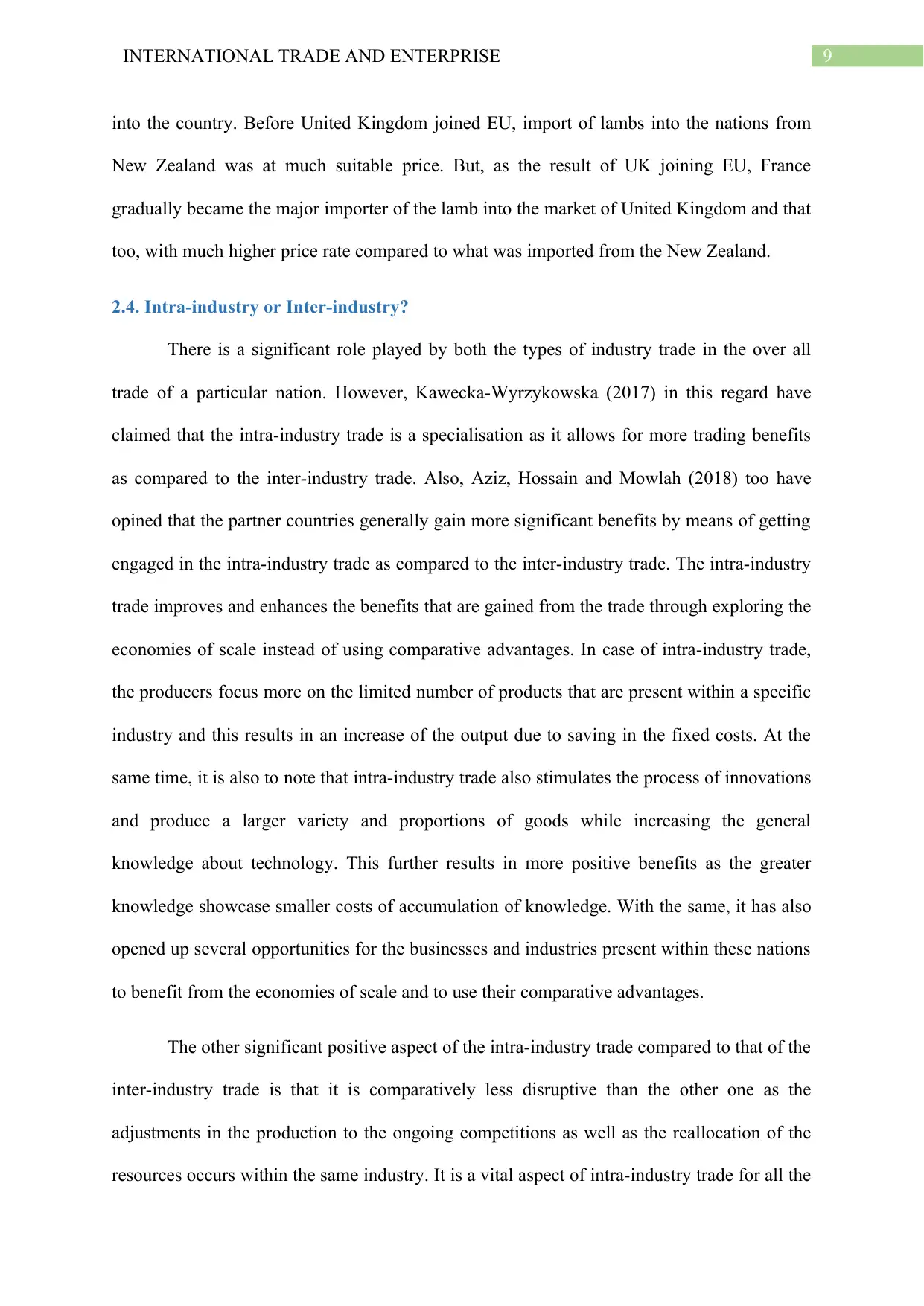
9INTERNATIONAL TRADE AND ENTERPRISE
into the country. Before United Kingdom joined EU, import of lambs into the nations from
New Zealand was at much suitable price. But, as the result of UK joining EU, France
gradually became the major importer of the lamb into the market of United Kingdom and that
too, with much higher price rate compared to what was imported from the New Zealand.
2.4. Intra-industry or Inter-industry?
There is a significant role played by both the types of industry trade in the over all
trade of a particular nation. However, Kawecka-Wyrzykowska (2017) in this regard have
claimed that the intra-industry trade is a specialisation as it allows for more trading benefits
as compared to the inter-industry trade. Also, Aziz, Hossain and Mowlah (2018) too have
opined that the partner countries generally gain more significant benefits by means of getting
engaged in the intra-industry trade as compared to the inter-industry trade. The intra-industry
trade improves and enhances the benefits that are gained from the trade through exploring the
economies of scale instead of using comparative advantages. In case of intra-industry trade,
the producers focus more on the limited number of products that are present within a specific
industry and this results in an increase of the output due to saving in the fixed costs. At the
same time, it is also to note that intra-industry trade also stimulates the process of innovations
and produce a larger variety and proportions of goods while increasing the general
knowledge about technology. This further results in more positive benefits as the greater
knowledge showcase smaller costs of accumulation of knowledge. With the same, it has also
opened up several opportunities for the businesses and industries present within these nations
to benefit from the economies of scale and to use their comparative advantages.
The other significant positive aspect of the intra-industry trade compared to that of the
inter-industry trade is that it is comparatively less disruptive than the other one as the
adjustments in the production to the ongoing competitions as well as the reallocation of the
resources occurs within the same industry. It is a vital aspect of intra-industry trade for all the
into the country. Before United Kingdom joined EU, import of lambs into the nations from
New Zealand was at much suitable price. But, as the result of UK joining EU, France
gradually became the major importer of the lamb into the market of United Kingdom and that
too, with much higher price rate compared to what was imported from the New Zealand.
2.4. Intra-industry or Inter-industry?
There is a significant role played by both the types of industry trade in the over all
trade of a particular nation. However, Kawecka-Wyrzykowska (2017) in this regard have
claimed that the intra-industry trade is a specialisation as it allows for more trading benefits
as compared to the inter-industry trade. Also, Aziz, Hossain and Mowlah (2018) too have
opined that the partner countries generally gain more significant benefits by means of getting
engaged in the intra-industry trade as compared to the inter-industry trade. The intra-industry
trade improves and enhances the benefits that are gained from the trade through exploring the
economies of scale instead of using comparative advantages. In case of intra-industry trade,
the producers focus more on the limited number of products that are present within a specific
industry and this results in an increase of the output due to saving in the fixed costs. At the
same time, it is also to note that intra-industry trade also stimulates the process of innovations
and produce a larger variety and proportions of goods while increasing the general
knowledge about technology. This further results in more positive benefits as the greater
knowledge showcase smaller costs of accumulation of knowledge. With the same, it has also
opened up several opportunities for the businesses and industries present within these nations
to benefit from the economies of scale and to use their comparative advantages.
The other significant positive aspect of the intra-industry trade compared to that of the
inter-industry trade is that it is comparatively less disruptive than the other one as the
adjustments in the production to the ongoing competitions as well as the reallocation of the
resources occurs within the same industry. It is a vital aspect of intra-industry trade for all the
Paraphrase This Document
Need a fresh take? Get an instant paraphrase of this document with our AI Paraphraser
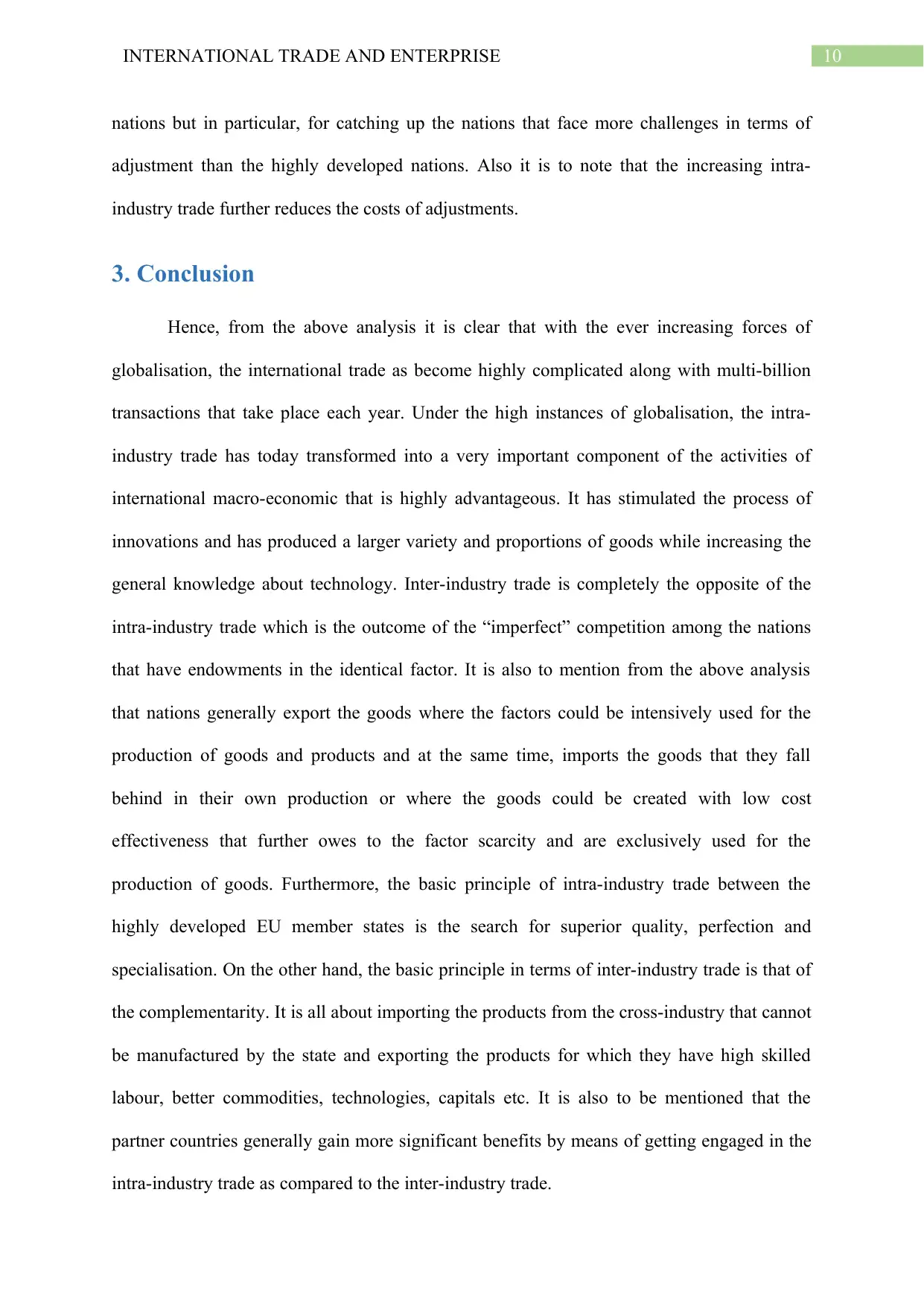
10INTERNATIONAL TRADE AND ENTERPRISE
nations but in particular, for catching up the nations that face more challenges in terms of
adjustment than the highly developed nations. Also it is to note that the increasing intra-
industry trade further reduces the costs of adjustments.
3. Conclusion
Hence, from the above analysis it is clear that with the ever increasing forces of
globalisation, the international trade as become highly complicated along with multi-billion
transactions that take place each year. Under the high instances of globalisation, the intra-
industry trade has today transformed into a very important component of the activities of
international macro-economic that is highly advantageous. It has stimulated the process of
innovations and has produced a larger variety and proportions of goods while increasing the
general knowledge about technology. Inter-industry trade is completely the opposite of the
intra-industry trade which is the outcome of the “imperfect” competition among the nations
that have endowments in the identical factor. It is also to mention from the above analysis
that nations generally export the goods where the factors could be intensively used for the
production of goods and products and at the same time, imports the goods that they fall
behind in their own production or where the goods could be created with low cost
effectiveness that further owes to the factor scarcity and are exclusively used for the
production of goods. Furthermore, the basic principle of intra-industry trade between the
highly developed EU member states is the search for superior quality, perfection and
specialisation. On the other hand, the basic principle in terms of inter-industry trade is that of
the complementarity. It is all about importing the products from the cross-industry that cannot
be manufactured by the state and exporting the products for which they have high skilled
labour, better commodities, technologies, capitals etc. It is also to be mentioned that the
partner countries generally gain more significant benefits by means of getting engaged in the
intra-industry trade as compared to the inter-industry trade.
nations but in particular, for catching up the nations that face more challenges in terms of
adjustment than the highly developed nations. Also it is to note that the increasing intra-
industry trade further reduces the costs of adjustments.
3. Conclusion
Hence, from the above analysis it is clear that with the ever increasing forces of
globalisation, the international trade as become highly complicated along with multi-billion
transactions that take place each year. Under the high instances of globalisation, the intra-
industry trade has today transformed into a very important component of the activities of
international macro-economic that is highly advantageous. It has stimulated the process of
innovations and has produced a larger variety and proportions of goods while increasing the
general knowledge about technology. Inter-industry trade is completely the opposite of the
intra-industry trade which is the outcome of the “imperfect” competition among the nations
that have endowments in the identical factor. It is also to mention from the above analysis
that nations generally export the goods where the factors could be intensively used for the
production of goods and products and at the same time, imports the goods that they fall
behind in their own production or where the goods could be created with low cost
effectiveness that further owes to the factor scarcity and are exclusively used for the
production of goods. Furthermore, the basic principle of intra-industry trade between the
highly developed EU member states is the search for superior quality, perfection and
specialisation. On the other hand, the basic principle in terms of inter-industry trade is that of
the complementarity. It is all about importing the products from the cross-industry that cannot
be manufactured by the state and exporting the products for which they have high skilled
labour, better commodities, technologies, capitals etc. It is also to be mentioned that the
partner countries generally gain more significant benefits by means of getting engaged in the
intra-industry trade as compared to the inter-industry trade.
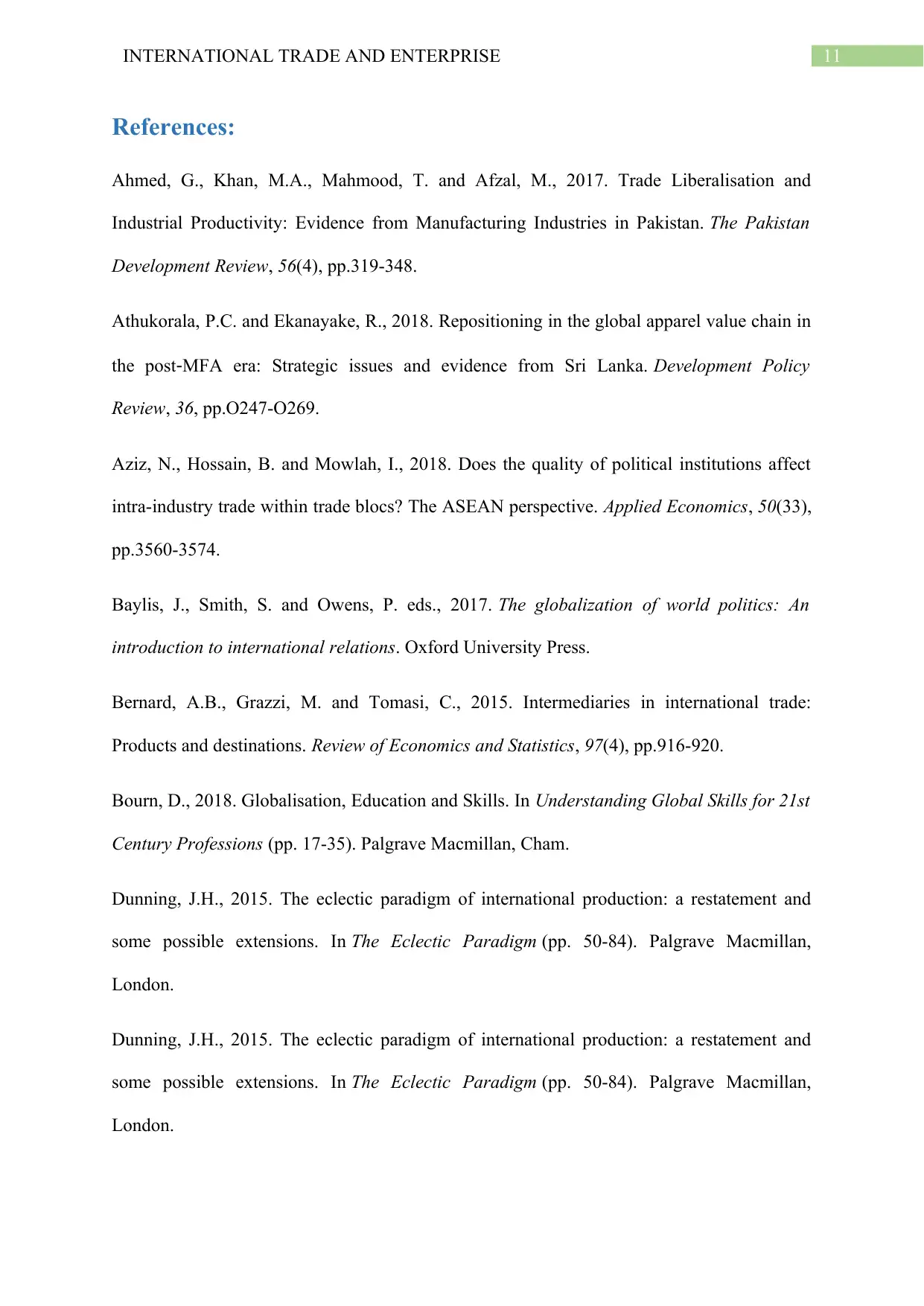
11INTERNATIONAL TRADE AND ENTERPRISE
References:
Ahmed, G., Khan, M.A., Mahmood, T. and Afzal, M., 2017. Trade Liberalisation and
Industrial Productivity: Evidence from Manufacturing Industries in Pakistan. The Pakistan
Development Review, 56(4), pp.319-348.
Athukorala, P.C. and Ekanayake, R., 2018. Repositioning in the global apparel value chain in
the post‐MFA era: Strategic issues and evidence from Sri Lanka. Development Policy
Review, 36, pp.O247-O269.
Aziz, N., Hossain, B. and Mowlah, I., 2018. Does the quality of political institutions affect
intra-industry trade within trade blocs? The ASEAN perspective. Applied Economics, 50(33),
pp.3560-3574.
Baylis, J., Smith, S. and Owens, P. eds., 2017. The globalization of world politics: An
introduction to international relations. Oxford University Press.
Bernard, A.B., Grazzi, M. and Tomasi, C., 2015. Intermediaries in international trade:
Products and destinations. Review of Economics and Statistics, 97(4), pp.916-920.
Bourn, D., 2018. Globalisation, Education and Skills. In Understanding Global Skills for 21st
Century Professions (pp. 17-35). Palgrave Macmillan, Cham.
Dunning, J.H., 2015. The eclectic paradigm of international production: a restatement and
some possible extensions. In The Eclectic Paradigm (pp. 50-84). Palgrave Macmillan,
London.
Dunning, J.H., 2015. The eclectic paradigm of international production: a restatement and
some possible extensions. In The Eclectic Paradigm (pp. 50-84). Palgrave Macmillan,
London.
References:
Ahmed, G., Khan, M.A., Mahmood, T. and Afzal, M., 2017. Trade Liberalisation and
Industrial Productivity: Evidence from Manufacturing Industries in Pakistan. The Pakistan
Development Review, 56(4), pp.319-348.
Athukorala, P.C. and Ekanayake, R., 2018. Repositioning in the global apparel value chain in
the post‐MFA era: Strategic issues and evidence from Sri Lanka. Development Policy
Review, 36, pp.O247-O269.
Aziz, N., Hossain, B. and Mowlah, I., 2018. Does the quality of political institutions affect
intra-industry trade within trade blocs? The ASEAN perspective. Applied Economics, 50(33),
pp.3560-3574.
Baylis, J., Smith, S. and Owens, P. eds., 2017. The globalization of world politics: An
introduction to international relations. Oxford University Press.
Bernard, A.B., Grazzi, M. and Tomasi, C., 2015. Intermediaries in international trade:
Products and destinations. Review of Economics and Statistics, 97(4), pp.916-920.
Bourn, D., 2018. Globalisation, Education and Skills. In Understanding Global Skills for 21st
Century Professions (pp. 17-35). Palgrave Macmillan, Cham.
Dunning, J.H., 2015. The eclectic paradigm of international production: a restatement and
some possible extensions. In The Eclectic Paradigm (pp. 50-84). Palgrave Macmillan,
London.
Dunning, J.H., 2015. The eclectic paradigm of international production: a restatement and
some possible extensions. In The Eclectic Paradigm (pp. 50-84). Palgrave Macmillan,
London.
⊘ This is a preview!⊘
Do you want full access?
Subscribe today to unlock all pages.

Trusted by 1+ million students worldwide
1 out of 13
Related Documents
Your All-in-One AI-Powered Toolkit for Academic Success.
+13062052269
info@desklib.com
Available 24*7 on WhatsApp / Email
![[object Object]](/_next/static/media/star-bottom.7253800d.svg)
Unlock your academic potential
Copyright © 2020–2025 A2Z Services. All Rights Reserved. Developed and managed by ZUCOL.




